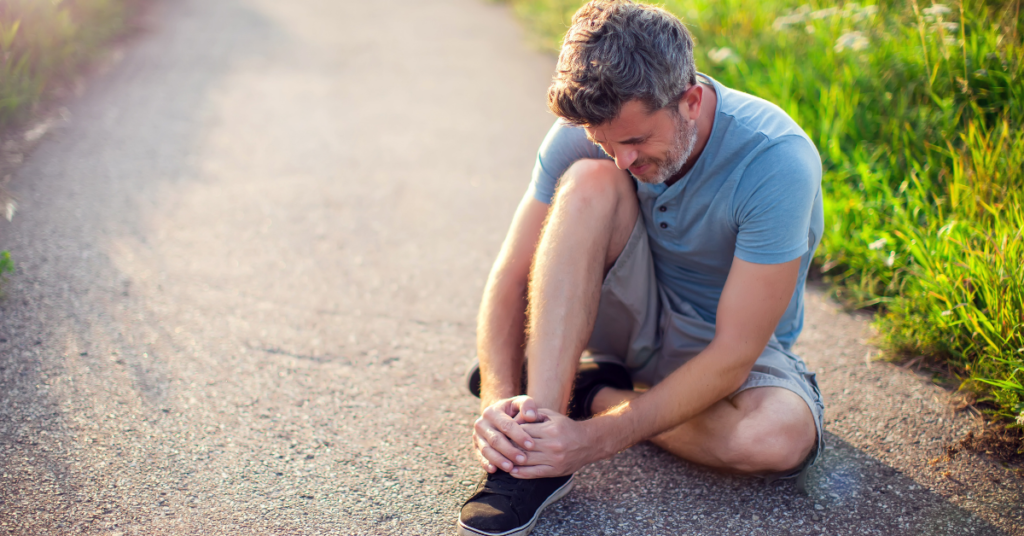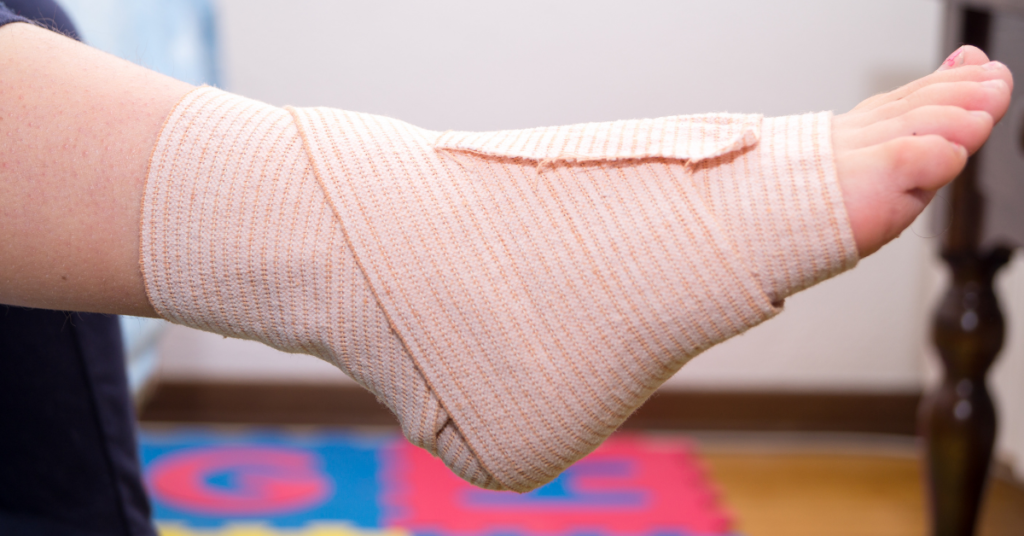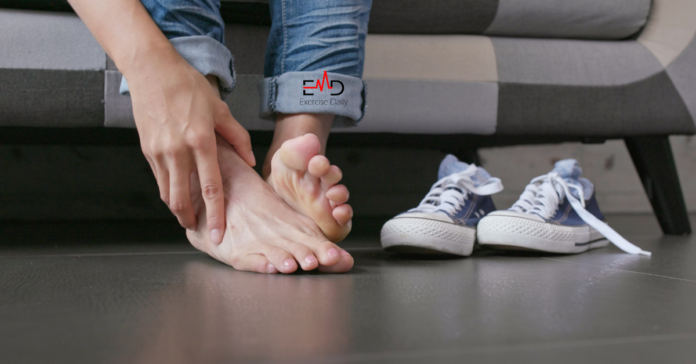Table of Contents
Exercise Daily – A bump on top of foot may occur if a person has an injury to their foot or ankle. Swelling can occur as a result of an injury. In the case of a bump that does not appear to have an evident origin, it might be a sign of another illness.
Symptoms of Bump on Top of Foot
The size, color, and hardness of bumps on the tops of the foot might vary depending on what formed them and what led them to appear.
Following are some of the symptoms that a person with a bump on their foot can experience:
- pain or discomfort
- stiffness
- patches of rough skin
- swelling or flushing
- difficult to wear shoes
- feeling uncomfortable while walking
A bump, on the other hand, might occur without any accompanying symptoms in some cases. Making a note of how the bump appears and feels will assist a doctor in making a diagnosis of the condition.
Causes of bump on the top of the foot

If you have spotted a bump on your foot, you have probably made a fast evaluation with queries like:
- Is it incredibly painful?
- Is it a soft or a harsh texture?
- Have you recently suffered an injury in the area?
- Is it a different shade of brown than the rest of your foot skin?
A bump on the top of your foot can be caused by a variety of different conditions. You may be able to determine the source of the problem with a simple inspection.
Some of the possible reasons for a bump on the top of the foot are as follows:
- Bone spur
- Bursitis
- Cutaneous horn
- Ganglion cyst
- Gout
- Hallux rigidus
- Lipoma
- Rheumatoid nodules
- Sebaceous cyst
Main Cause of Bump on Top of Foot
The main cause of lump or bump on top of foot is Bone Spur. However, despite the fact that they have a terrible-sounding name, bone spurs are not always unpleasant.
Actually, they’re smooth projections that protrude from your bones, which are commonly found when two bones come together in a joint.
It is considerably more usual for bone spurs to occur after the age of 60, a condition known as osteoporosis (bony growth). Bone spurs can occur in children and teenagers, as well as in adults.
Osteoarthritis is a risk factor for bone spurs, so if you have it, be aware of the symptoms you may experience and when it may be important to seek treatment.
Bone spur
A bone spur that originates out of a joint on the top of your foot is known as a dorsal boss, dorsal exostosis, and tarsal boss, depending on where it is located. It is characterized by an increase in bone tissue development.
Typically, bone spurs form as a result of your body producing more bone in an attempt to cure the damage caused by repeated stress or pressure exerted on a bone over an extended period of time.
Despite the fact that bone spurs can form in any bone, they are more frequent in the joints. Often, joint deterioration linked with osteoarthritis is the source of these symptoms.
Risk factors for Bone Spurs/ Bump on Top of Foot

.There are a variety of factors that increase the likelihood of getting a bone spur on foot. These risk factors for osteoarthritis, in addition to the disease itself, are as follows:
Age
The older you become, the greater your chances of developing a bone spur are. Cartilage degrades overage, and the body’s response to this steady wear and tear is to generate more bone in an attempt to heal the damage it has sustained.
Physical Activity
Physical activity on a regular basis helps you maintain a healthy weight and increases your energy level. However, it can also place additional stress on your feet, increasing your chance of developing bone spurs.
Wearing Tight Shoes
Shoes that are too tight might pinch your toes and generate constant friction on your foot and toes.
Injury
The development of bone spurs can occur following a small injury such as a bruise or following a fracture.
Obesity
Having too much weight puts additional strain on your feet and other bones. This can cause your cartilage to break down more quickly, resulting in the formation of a bone spur.
Flat Feet
When you stand, having a low or nonexistent arch in your feet might cause your entire foot to come into contact with the surface of the floor.
This puts additional strain on your joints, which can lead to a variety of issues such as hammertoe, blisters, bunions, and bone spurs, among others. So, having flat feet can also cause bump on top of foot.
Treatment of Bone Spurs on the Top of the Foot
If you have a bone spur that does not produce symptoms, you do not require treatment. Whereas a bone spur will not go away on its own, there are several alternatives for relieving the resulting discomfort:
Weight Loss
Losing weight alleviates strain on the bones in your foot and the discomfort associated with a bone spur by reducing your body weight. Here are a few simple tips:
- Make time for physical activity three times each week for at least 30 minutes.
- cut back on your calorie consumption
- Make use of portion control techniques.
- Increase your intake of fruits, veggies, lean meats, and healthy grains.
- Reduce your consumption of sweets, fried meals, and fatty foods.
Change Your Shoes or Put on Some Padding
When it comes to bone spur symptoms, changing your footwear might help, especially if you spend a lot of time on your feet.
In order to avoid pain and fatigue, choose shoes that don’t squeeze your toes or are too loose.
If you want to add a little additional room, wear shoes with rounded or square toes. If you have a low arch, you might consider adding extra padding to your shoes to alleviate the strain.
Use of Heat and Ice
It may also be beneficial to alternate between cold and heat therapy while treating a bone spur to alleviate the discomfort.
While heat can help to alleviate pain and stiffness, ice can help to reduce inflammation and swelling. For 10 to 15 minutes, many times a day, apply a cold pack or heating pad to the bottom of your foot.
Using heat or ice packs is an excellent choice to relieve symptoms of bump on top of foot.
Injection of Cortisone
Consult with your doctor to determine whether you are a candidate for a cortisone injection, which can help reduce inflammation.
It is administered directly into your bone by a doctor in order to alleviate pain, rigidity, and swelling.
Try Walking Boots
Walking boots are intended to provide protection for the foot following an accident or surgical treatment. They can also be used to alleviate the pressure and discomfort related to a bone spur.
Use Pain Killers
Inflammation and pain associated with a bone spur can be alleviated by over-the-counter pain medications (ibuprofen, acetaminophen, or naproxen sodium). However, take such medications as directed by the physician or doctor.
Surgery
A doctor may prescribe that you have a bone spur removed. When a bone spur causes significant discomfort or restricts movement, surgery is typically the only choice.
Home Remedies for Bump on Top of Foot

If a person has hurt their foot, taking over-the-counter pain relievers and resting may be beneficial. A bump, on the other hand, that is caused by a chronic disease such as gout may need continuous care.
At home, a person might try the following ways to alleviate symptoms:
For Pain and Discomfort
Taking over-the-counter pain relievers and NSAIDs for a short period of time might be beneficial.
Before administering these drugs to children, people should consult with a pharmacist. Additionally, some may not be appropriate for pregnant women.
To Reduce Swelling
In situations of gout, bunions, bursitis, or arthritis, applying ice to the affected area may assist in decreasing local swelling and irritation.
To Reduce Discomfort while Walking
A person who has a long-term ailment may need to make sure that their shoes are comfortable and have enough room to support the bump on their foot. They may also require walking aids to assist them in their movement.
Other Possible Cause of Bump on Top of Foot
The following are the other possible cause of having a bump or lump on top of your foot:
Bursitis
Several small sacs loaded with lubricating fluid are located around your joints to decrease friction and discomfort between bone, tendons, muscles, and skin. Bursae are the medical term for these sacs.
Bursitis is the consequence of either of these sacs being inflamed, which causes pain and swelling. It can be painful and might make it difficult to move.
Bursitis can manifest itself in a variety of locations across your body, including the top of your big toe, which is the point at which your toe and foot come together.
Resting the affected region, using ice, and, if necessary, taking an over-the-counter (OTC) nonsteroidal anti-inflammatory medication such as ibuprofen or aspirin might alleviate the symptoms, which generally last a few weeks.
Contact your doctor if any of the following situations occur:
- It has been two weeks since you first noticed symptoms of bursitis
- Your discomfort has grown acute
- Significant swelling in the afflicted area.
Cutaneous horn
An uncommon disease characterized by horns on the face, neck, and shoulders, cutaneous horns can appear anywhere on the body. They can sometimes be found on the bottom of the foot.
The growths are composed of keratin that is a protein present in the epidermis of the skin’s uppermost layer. The name originates from the rough, spiky form of the flower, which is meant to mimic an animal’s horn.
If you suspect you have a cutaneous horn, you should see your doctor right once since it might be cancerous. After being diagnosed with cutaneous horn, contact your doctor if you notice any of the following symptoms:
- Inflammation in the region
- Fast growth
- Horn at its base hardens
So Cutaneous horn may be a cause of a bump on top of foot, but that is rare.
Ganglion cyst
Ganglion cysts are tissue lumps filled with a jelly-like fluid. They might vary in size from unnoticeable to one inch or more. They are not malignant, and they are not cancerous.
A person may well have no or no symptoms:
- Tingling in the region affected
- numbness
- Mobility loss
While ganglion cysts occasionally go untreated, you may opt to remove them. Your surgeon will remove the cyst by surgery or remove the cyst by draining the syringe fluid.
Gout
Gout is the outcome of an accumulation of uric acid crystals. It causes inflammation and swelling in the foot around your big toe. The discomfort and burning feeling might abruptly happen.
Your doctor may do a blood test, an X-ray, or a diagnostic ultrasound. You will probably propose treatment medicine. Modifications to the lifestyle to control symptoms include dietary changes and the cessation of smoking.
Hallux rigidus
Hallux rigidus is a kind of arthritis that happens at the bottom of your big toe if you injure or lose cartilage. It occurs between the ages of 30 to 60. It causes discomfort and stiffness when you walk, or you cannot move your big toe.
Treatment alternatives include bathing your feet (alternating warm and cold water) plus wearing shoes to avoid bending your big toe. In certain circumstances, your doctor may prescribe surgery if your disease worsens over time.
So, this type of arthritis can cause bump on top of foot.
Lipoma
You may have a lipoma when a lump underneath your skin feels soft when you touch and readily move with your finger. Lipoma is a non-cancerous fatty tissue development. The top of your foot might appear anywhere on your body.
Your doctor may take a physical exam or biopsy to screen for lipoma. Because they are usually regarded as harmless, your doctor may urge you to leave them alone. A lipoma can be removed surgically if necessary.
Rheumatoid nodules
You might grow steady lumps beneath the skin called rheumatoid nodules when you have rheumatoid arthritis. They might be as big as tiny as a walnut. They generally happen around arthritis-affected joints.
Rheumatoid nodules are generally not painful unless they are near a nerve or if the inflammation is underlying. If your rheumatoid lumps do not diminish with medication for rheumatoid arthritis such as DMARDs, your doctor may offer an alternative treatment.
Asteroid injection might be included directly in the nodules. If the nodules seriously restrict or get infected with the articulation, your doctor may prescribe surgical removal.
Sebaceous cyst
Sebaceous cysts are closed cysts that develop under the skin and are non-cancerous. It is due to clogged glands or enlarged skin hair follicles. Tombocysts generally develop on the face or neck but also form on your foot.
Your doctor may consider injecting a steroid medication into your cyst or surgically removing it if the cyst turns bothersome, such as irritating your shoes.
Bump on Top of Foot – FAQs
What does a ganglion cyst look like on top of foot?
Despite the fact that they can develop anywhere on foot, they are more frequently found on the top. The size can range from the size of a pea to that of a golf ball, depending on the variety.
The cyst may seem spherical and be soft or very firm, depending on its size and location. A ganglion cyst appears like a balloon on a stalk beneath the skin, and it has the ability to move freely beneath the skin if a person presses it.
What is the hard bump on my foot?
Plantar fibromas are another form of bump that can be discovered on foot. These benign masses, which are typically painless, are fibrous, hard nodules that develop inside the ligaments of the foot.
They are most commonly seen in the arch area on the bottom of the foot. These bumps are usually less than an inch in diameter, although they can grow in size over time as well.
Can a lump on top of foot be cancer?
As soon as you see a bump on your foot, you should have it examined by a podiatrist. While the majority of foot tumors are benign, there are those that are cancerous.
To keep cancer from spreading, malignant tumors must be treated as soon as possible.
Can I get a bone spur on the top of my foot?
Bone spurs are a typical occurrence on foot as a result of the amount of pressure put on the bones of the foot.
It’s likely that if you have a bone spur on your foot, it will emerge on the top of your mid-foot. Additionally, you may experience toe or heel spur development.






